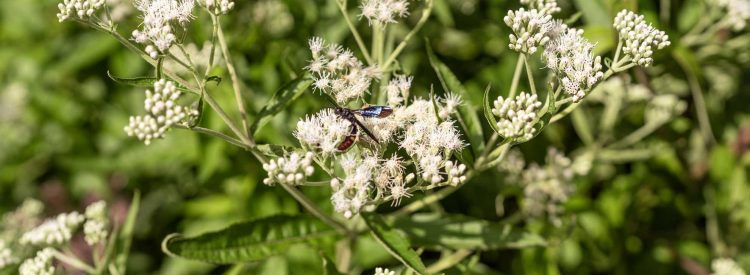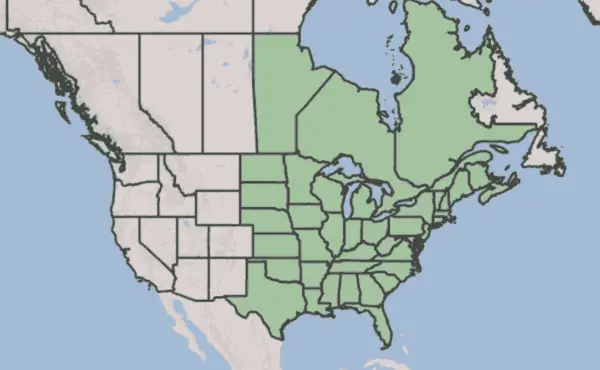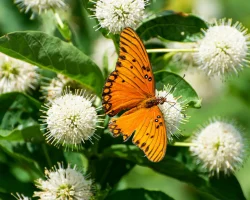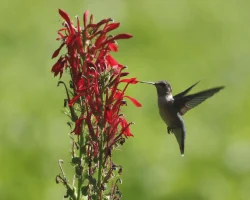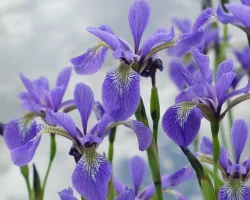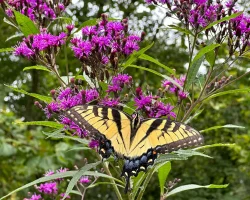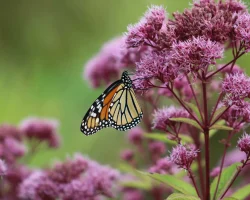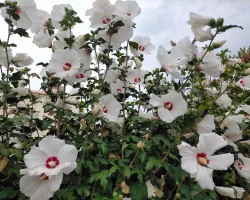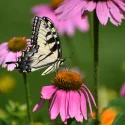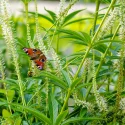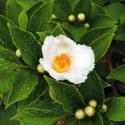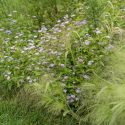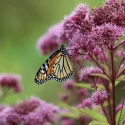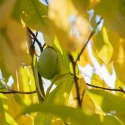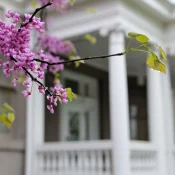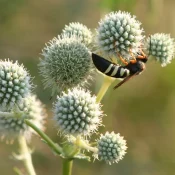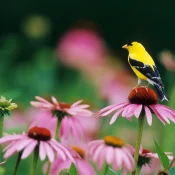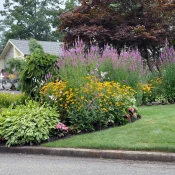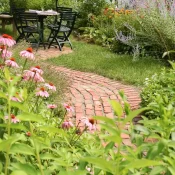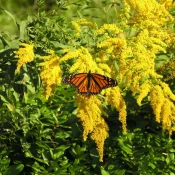Forget the strange and macabre name (we’ll tell you where it comes from in a minute). Bonesets are tremendous flowers—tall, majestic, and an important food source for pollinators at the end of the growing season. Like another tall native Joe Pye weed, boneset grows 4-6′ and opens up nectar-filled umbrellas of flowers at the end of summer into fall. They are stunning from afar, but be sure to get up close to appreciate dozens of pollinators zipping around. Scroll on for planting tips.
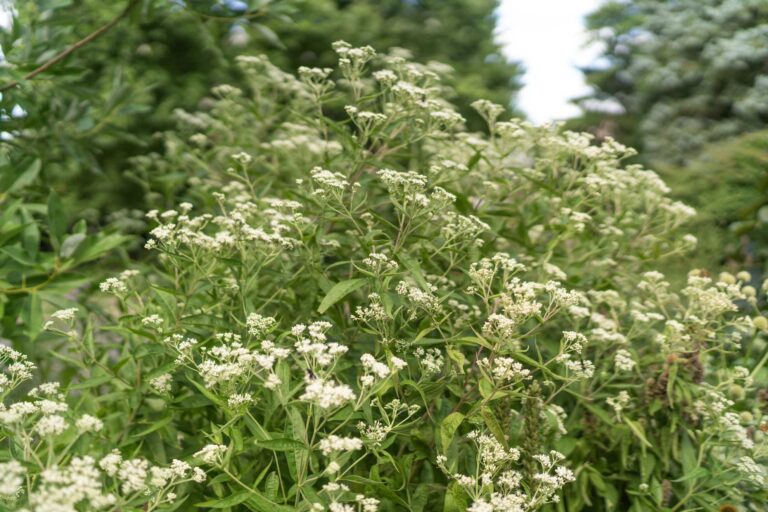
Is boneset a good choice for my yard?
Yes, if…
- You want a tall, dramatic flower that feeds pollinators when other blooms have faded.
- You have a moist garden spot—a place where water pools after rain or along a stream, pond, or rain-collecting area.
- You’re building a pollinator garden or want to support Monarch migration.
- You like plants that come back year after year with little care (perennials).
Why boneset matters
- Late-season lifeline: Provides nectar when other flowers have gone to seed.
- Time-saver: Low-maintenance, no fertilizer needed, thrives on rainfall alone.
And one more benefit to planting boneset… 🦋

Boneset is a host plant for 42 butterflies and moths
A host plant is a species that a butterfly or moth lays its eggs on and/or its caterpillars eat. Planting boneset helps dozens of iconic butterflies and moths, including:
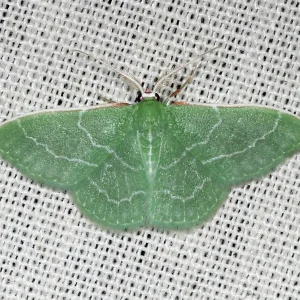
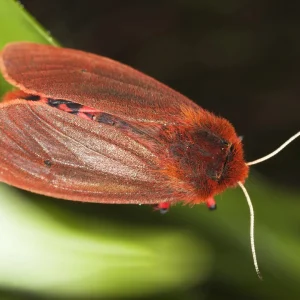
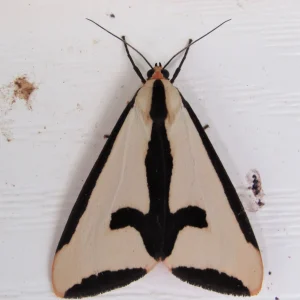
New to native?
Before lawns and landscaping, native plants were here. They’ve fed birds, bees, and butterflies for thousands of years—and they’ll do the same in your yard. The best part? They’re easier to grow than you think.
Where it grows naturally
In the wild, boneset grows in wet meadow communities or places where sunlight and water meet. You’ll find it along streams, ditches, and pond edges surrounded by Joe Pye weed, swamp milkweed, and blue vervain.
In a yard, that looks like low spots, rain gardens, or areas that stay damp after rain. Planting boneset there recreates a slice of that natural community, and a late-summer haven for bees, butterflies, and migrating monarchs.
How to grow boneset
There are a few things to note as you consider planting boneset in your yard:
- Make sure boneset gets consistent moisture. As mentioned, in nature, Boneset is found alongside waterways. Mimic this environment by putting them in areas alongside water or where water pools after rain.
- Give them space. Boneset will spread over the years and form a colony of plants. Plant them where they have space to spread out.
- They get tall—4-6’—as large as most adults. Put them in the back of pollinator gardens surrounded by medium and short-height flowers.
However, even if your garden experiences short periods of drought, established bonesets can survive. (The two-year-old boneset in my PA garden has received zero watering and is still in full bloom, even with several weeks of no rain.)
Why is it called boneset?
Boneset’s unusual name comes from early beliefs that it could ease pain, especially in cases of “Breakbone Fever,” now known as Dengue Fever. Native Americans and early settlers used boneset in herbal remedies to reduce fevers and promote healing, believing it could even aid in mending broken bones.
However, if you’re thinking about using it as a remedy, be aware: the U.S. Forest Service warns that boneset can be emetic and laxative in large doses and may contain pyrrolizidine alkaloids, which are potentially harmful to the liver.
Do any other plants have weird names like this?
Yes! Many plants have common names that reflect their long-ago medicinal uses. Others include: rattlesnake master and Joe Pye weed. For native plants currently in medicine cabinets, visit our Beginner’s Guide to Coneflowers (aka Echinacea).
One last story about its Latin name
This next part of boneset’s story is worthy of a Hollywood movie.
Its Latin genus name, Eupatorium, honors Mithridates VI Eupator, a 1st-century BCE king known for his wars against the Roman Republic and expertise in herbal medicine. Mithridates is said to have regularly ingested small amounts of poison to help build immunity. When Latin botanical naming was introduced in the 1700s, Eupatorium was chosen as the genus name to link to this mythical story.
Where is boneset native?
Boneset is native to half of North America, from Nova Scotia to the Midwest United States.
Where boneset shines in your yard
Boneset is a standout in rain gardens and damp areas, but it’s not limited to wet spots. Once established, it can also handle average garden soil, making it a versatile choice for many yards. Its tall height (4–6 feet) means it shines in the back of pollinator beds or naturalized plantings where it can tower gracefully over shorter companions. In late summer, its cloud-like clusters of white flowers glow in the garden and draw in a frenzy of bees, butterflies, and even migrating monarchs—making it both a pollinator lifeline and a dramatic garden centerpiece.
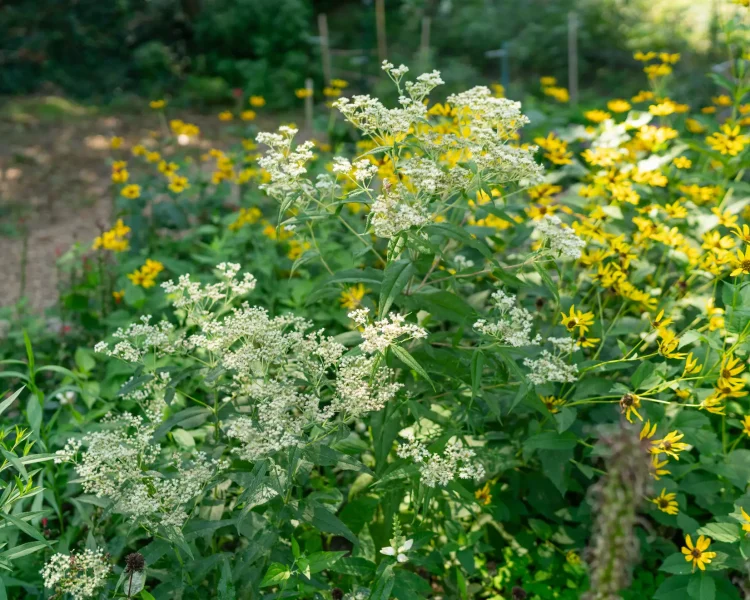
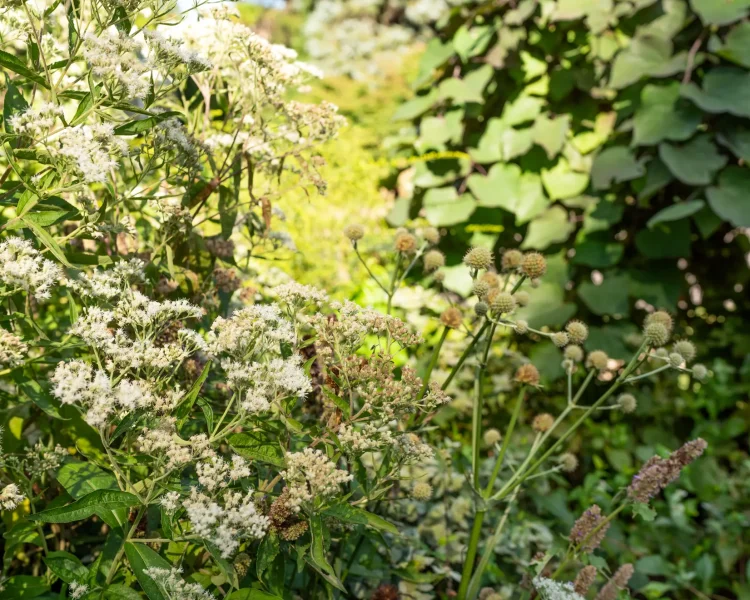
Where can I find boneset?
We are not going to lie and say that finding boneset is going to be as simple as driving to your closest plant nursery. It might take a little extra energy to find this native gem, but it is worth it! Here are some recommendations for sourcing this native plant:
Where can I find seeds and plants?
Finding native plants can be challenging (we partly blame Marie Antoinette.) To make it easier, we’ve assembled four sourcing ideas.
300+ native nurseries make finding one a breeze
Explore 100+ native-friendly eCommerce sites
Every state and province has a native plant society; find yours
Online Communities
Local Facebook groups are a great plant source
What are good pairings for boneset?
Boneset likes consistent moisture. Pair with other natives that thrive in this environment, like Joe Pye weed and cardinal flower.

Pairs well with
And that sums up our beginner’s guide to native flower boneset. Put aside the strange common name—or perhaps embrace it with a garden nametag. These stunning flowers open umbrellas of much-needed nectar and pollen at the end of the growing season, from late summer into fall. Because they are perennials, plant once and enjoy them for years. Looking to explore some other strangely named plants? Head over to our Terrible Names, Beautiful Natives, or our Beginner’s Guide to Joe Pye Weed. Happy planting!
Sources
- Drugs.com. “Boneset Uses, Benefits & Side Effects Herbal Database,” n.d. https://www.drugs.com/npc/boneset.html.
- Missouri Department of Conservation. “Thoroughworts (Bonesets),” n.d. https://mdc.mo.gov/discover-nature/field-guide/thoroughworts-bonesets.
- Britannica, T. Editors of Encyclopaedia. “Eupatorium.” Encyclopedia Britannica, September 7, 2016. https://www.britannica.com/plant/Eupatorium.
- United States Department of Agriculture, Boneset Fact Sheet (PDF).
- Georgia Southern University. “Boneset | Facilities Services” January 3, 2020. https://www.georgiasouthern.edu/finops/facilities/landscape-services/arboretum/major-collections/physic-garden/boneset/.
- “Eupatorium Perfoliatum (American Boneset, Boneset, Bonset, Feverwort, Thoroughwort).” North Carolina Extension Gardener Plant Toolbox, n.d. https://plants.ces.ncsu.edu/plants/eupatorium-perfoliatum/.
- Clayton, John. Virginia Native Plant Society. “Boneset – August 2016 Wildflower of the Month.” https://vnps.org/johnclayton/2016/09/13/boneset-august-2016-wildflower-of-the-month/.
- Wikipedia contributors. “Mithridates VI Eupator.” Wikipedia, July 26, 2024.
- Jersey-Friendly Yards. “Eupatorium Perfoliatum,” November 16, 2021.
- Tallamy, Doug. University of Delaware, “20 Most Valuable Woody and Perennials Native Plant Genera in Terms of Supporting Biodiversity in the Mid-Atlantic Region.”
- National Wildlife Foundation. “Plant Information – Native Plants Finder,” 2015.
- Butterfliesandmoths.org. “Ruby Tiger Moth Phragmatobia Fuliginosa (Linnaeus, 1758) | Butterflies and Moths of North America,” 2024.
- Butterfliesandmoths.org. “Clymene Moth Haploa Clymene (Brown, 1776) | Butterflies and Moths of North America,” 2025.
What if your feed was actually good for your mental health?
Give your algorithm a breath of fresh air and follow us.
